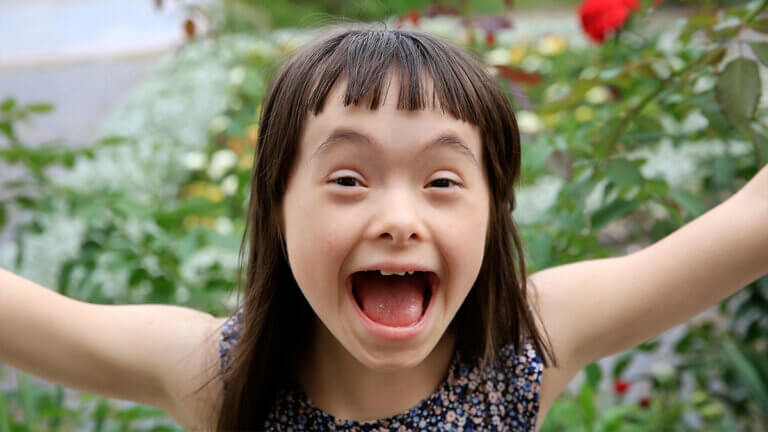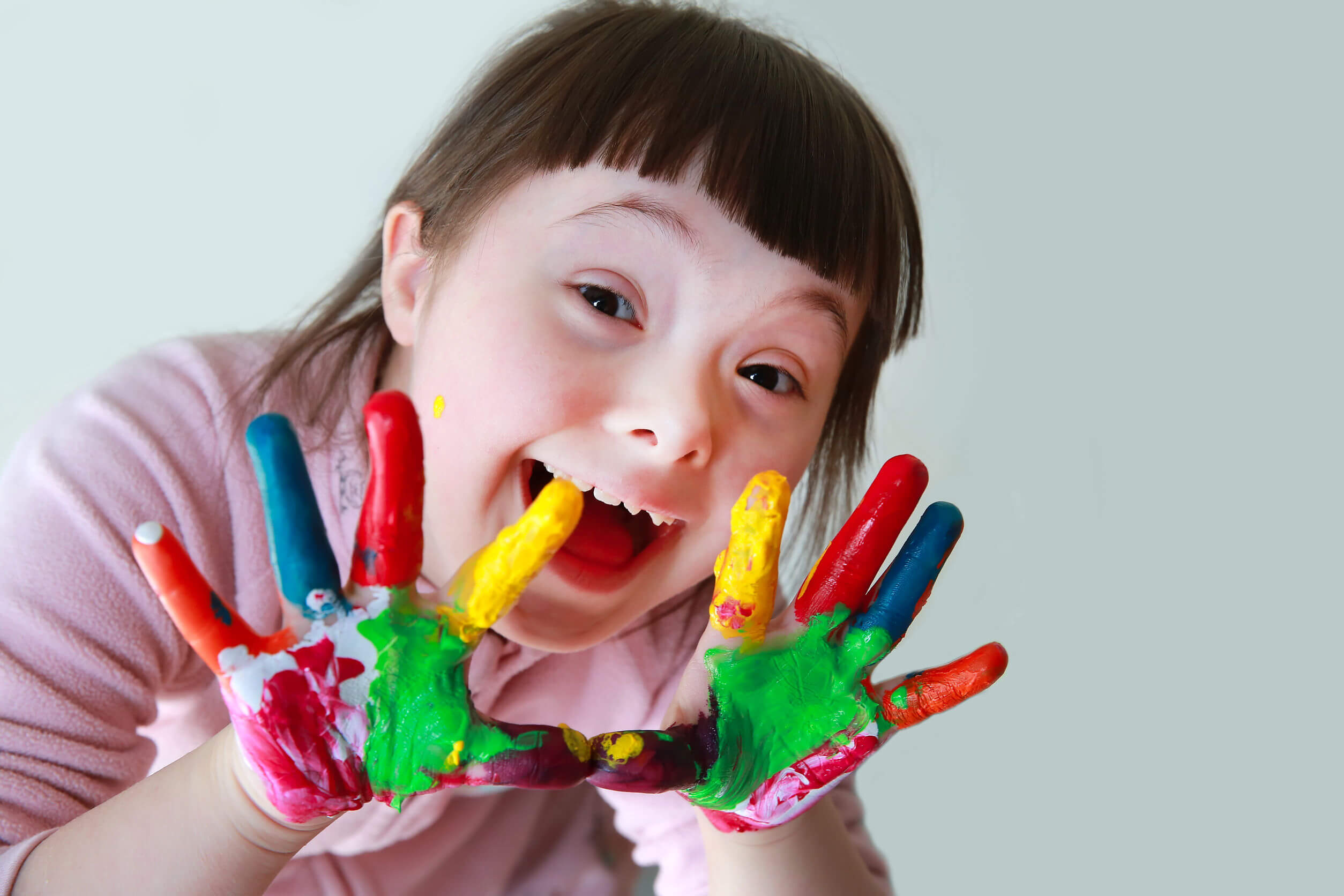Down Syndrome Symptoms

Down syndrome is a genetic condition in which a person has an extra chromosome (chromosome 21, which is called trisomy 21). It’s a condition that has no cure. But what do we know about Down syndrome symptoms? What are the most common ones?
One of them is the intellectual and developmental disability that it causes, although there are more. We’ll get to know them throughout this article.
Physical characteristics in Down syndrome

People with Down syndrome share a set of facial and physical features that are quite recognizable. These traits are evident at birth, although they can become more pronounced over time. According to data from the Centers for Disease Control and Prevention, these physical signs include the following:
- Small ears
- A large tongue that can stick out of the mouth
- A round face with a flat profile
- Small nose and mouth
- A small head, somewhat flat on the back (brachycephaly)
- Almond-shaped eyes, with skin covering the inside of the eye (called the epicanthic fold)
- White spots in the colored part of the eyes (Brushfield spots)
- A short neck
- A single fold in the palm of each hand (usually there are two)
- Short, stubby fingers and a little finger that curves inward
- A short, chubby build
- Small feet with a larger than normal space between the big toe and the second toe
- Low muscle tone (babies with the syndrome often appear “floppy” due to hypotonia).
Complexity, hypotonia, and related complications
We know that children with Down syndrome, when they’re born, are usually of average size. However, they tend to grow at a slower rate, and are smaller than other children of their age. On the other hand, it’s also common for these children to end up becoming overweight.
Regarding hypotonia (low muscle tone), although this can be improved (and often does with age and physical therapy), most of these children reach developmental milestones later than other children (sitting, crawling, and walking).
In addition, this low muscle tone can contribute to the development of eating problems and motor delays. Delays in speech and learning skills such as eating, dressing, and learning to go to the bathroom may appear in childhood.
Intellect and development
People with Down syndrome develop an intellectual disability, which can be mild, moderate, or severe. There’s also a delay in development.
This means that they tend to learn more slowly, and that they can have problems when making judgments, reasoning, etc. In short, everything that concerns putting their cognitive skills into practice.
The challenges related to this group can be classified into four categories:
Development of motor skills
Their development is slow in this regard. Delays in reaching these milestones mean that the child may take longer to move, walk, and use their hands and mouth. This can reduce opportunities to explore their world and to learn. In addition, it can affect cognitive development and compromise other skills such as language.
Language
Several areas of language are affected: expressive language, grammar, and clarity of speech. Due to developmental delays in understanding language, most of these children are slow to master sentence structure and grammar.
They may also have trouble speaking clearly, which can lead to frustration and behavior problems. On the other hand, language can underestimate the cognitive abilities of these children.
Memory
Another of the symptoms of Down syndrome has to do with their memory skills. They may show difficulties in retaining and processing the information that comes to them verbally; however, they’re better at remembering what they see visually.
This can be a disadvantage for them in classrooms, where most information is taught through oral language.
Psychological characteristics

Although they’re sometimes considered -on a social level- to be very happy, sociable, and outgoing people, the truth is that each person is different. Also, it’s important not to stereotype (even in a “positive” way).
What psychological characteristics can people with Down syndrome have? Some of them are the following:
- The need for order and routine in the face of the complexities of daily life.
- Self-talk (according to the Children’s Hospital of Philadelphia, people with Down syndrome use self-talk as a way to process information and analyze things).
- Extroversion.
Medical complications
People with Down syndrome are more likely than people without the condition to develop certain symptoms or pathologies. Among the most frequent, we find the following:
- Hearing loss and ear infections
- Vision or eye health problems
- Infections
- Obstructive sleep apnea
- Musculoskeletal problems
- Heart defects
- Epilepsy
- Gastrointestinal disorders
- Hypothyroidism
- Blood disorders
- Mental health problems
We’ve seen the most common Down syndrome symptoms. However, it’s clear that each specific case will have different symptoms and to a greater or lesser degree. This will depend a lot on the type of trisomy, early intervention, and other factors.
“I don’t have a disability, I have a different ability.”
-Anonymous-
Down syndrome is a genetic condition in which a person has an extra chromosome (chromosome 21, which is called trisomy 21). It’s a condition that has no cure. But what do we know about Down syndrome symptoms? What are the most common ones?
One of them is the intellectual and developmental disability that it causes, although there are more. We’ll get to know them throughout this article.
Physical characteristics in Down syndrome

People with Down syndrome share a set of facial and physical features that are quite recognizable. These traits are evident at birth, although they can become more pronounced over time. According to data from the Centers for Disease Control and Prevention, these physical signs include the following:
- Small ears
- A large tongue that can stick out of the mouth
- A round face with a flat profile
- Small nose and mouth
- A small head, somewhat flat on the back (brachycephaly)
- Almond-shaped eyes, with skin covering the inside of the eye (called the epicanthic fold)
- White spots in the colored part of the eyes (Brushfield spots)
- A short neck
- A single fold in the palm of each hand (usually there are two)
- Short, stubby fingers and a little finger that curves inward
- A short, chubby build
- Small feet with a larger than normal space between the big toe and the second toe
- Low muscle tone (babies with the syndrome often appear “floppy” due to hypotonia).
Complexity, hypotonia, and related complications
We know that children with Down syndrome, when they’re born, are usually of average size. However, they tend to grow at a slower rate, and are smaller than other children of their age. On the other hand, it’s also common for these children to end up becoming overweight.
Regarding hypotonia (low muscle tone), although this can be improved (and often does with age and physical therapy), most of these children reach developmental milestones later than other children (sitting, crawling, and walking).
In addition, this low muscle tone can contribute to the development of eating problems and motor delays. Delays in speech and learning skills such as eating, dressing, and learning to go to the bathroom may appear in childhood.
Intellect and development
People with Down syndrome develop an intellectual disability, which can be mild, moderate, or severe. There’s also a delay in development.
This means that they tend to learn more slowly, and that they can have problems when making judgments, reasoning, etc. In short, everything that concerns putting their cognitive skills into practice.
The challenges related to this group can be classified into four categories:
Development of motor skills
Their development is slow in this regard. Delays in reaching these milestones mean that the child may take longer to move, walk, and use their hands and mouth. This can reduce opportunities to explore their world and to learn. In addition, it can affect cognitive development and compromise other skills such as language.
Language
Several areas of language are affected: expressive language, grammar, and clarity of speech. Due to developmental delays in understanding language, most of these children are slow to master sentence structure and grammar.
They may also have trouble speaking clearly, which can lead to frustration and behavior problems. On the other hand, language can underestimate the cognitive abilities of these children.
Memory
Another of the symptoms of Down syndrome has to do with their memory skills. They may show difficulties in retaining and processing the information that comes to them verbally; however, they’re better at remembering what they see visually.
This can be a disadvantage for them in classrooms, where most information is taught through oral language.
Psychological characteristics

Although they’re sometimes considered -on a social level- to be very happy, sociable, and outgoing people, the truth is that each person is different. Also, it’s important not to stereotype (even in a “positive” way).
What psychological characteristics can people with Down syndrome have? Some of them are the following:
- The need for order and routine in the face of the complexities of daily life.
- Self-talk (according to the Children’s Hospital of Philadelphia, people with Down syndrome use self-talk as a way to process information and analyze things).
- Extroversion.
Medical complications
People with Down syndrome are more likely than people without the condition to develop certain symptoms or pathologies. Among the most frequent, we find the following:
- Hearing loss and ear infections
- Vision or eye health problems
- Infections
- Obstructive sleep apnea
- Musculoskeletal problems
- Heart defects
- Epilepsy
- Gastrointestinal disorders
- Hypothyroidism
- Blood disorders
- Mental health problems
We’ve seen the most common Down syndrome symptoms. However, it’s clear that each specific case will have different symptoms and to a greater or lesser degree. This will depend a lot on the type of trisomy, early intervention, and other factors.
“I don’t have a disability, I have a different ability.”
-Anonymous-
- American Psychiatric Association -APA- (2014). DSM-5. Manual diagnóstico y estadístico de los trastornos mentales. Madrid. Panamericana.
- Arbea L y Paternanin C. Trastornos graves del desarrollo: la potenciación de la comunicación como principal herramienta comunicativa. En: VV.AA. Comunicación y programas de tránsito a la vida adulta en personas con necesidades de apoyo generalizado. Gobierno de Navarra. Departamento de Educación y Cultura 1998.
- Caballo, V. y Simón, M. A. (2002). Manual de Psicopatología Clínica Infantil y del adolescente. Trastornos generales. Pirámide: Madrid.
- Centers for Disease Control and Prevention. Facts about Down Syndrome
- Children’s Hospital of Philadelphia. ‘Self-Talk’ in Adults with Down Syndrome
- Starbuck JM, Cole TM, Reeves RH, Richtsmeier JT. Trisomy 21 and facial developmental instability. Am J Phys Anthropol. 2013;151(1):49-57. doi:10.1002%2Fajpa.22255
Este texto se ofrece únicamente con propósitos informativos y no reemplaza la consulta con un profesional. Ante dudas, consulta a tu especialista.







